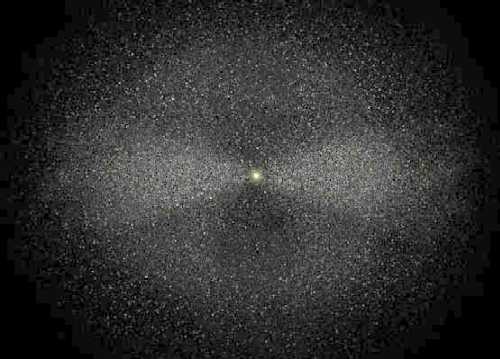Kuiper Belt & Oort Cloud
![]()
|
The Kuiper belt is a disk-shaped region past the orbit of Neptune roughly 30 to 100 AU from the Sun containing many small icy bodies. It is now considered to be the source of the short-period comets. There are at least 70,000 "trans-Neptunians" with diameter larger than 100 km in the zone extending outwards from the orbit of Neptune. |
||
|
First Kuiper Belt object was discovered in 1992. It was given provisional designation 1992 QB1. There are more than one hundred discovered objects so far. |
||
|
The Kuiper Belt holds significance for the study of the planetary system on at least two levels:
|
|
There are many Kuiper Belt objects that orbit in 3:2 resonance with Neptune (as does Pluto). Some believe that Triton, Pluto and its moon Charon are merely the largest examples of Kuiper Belt objects. 1998 WW31 is the second transneptunian object (after Pluto) to have a satellite. |
|
In 1950. Jan Oort noticed that:
|
| From this he proposed that comets reside in a vast cloud at the outer reaches of the Solar System. This has come to be known as the Oort Cloud. The statistics imply that it may contain many as trillion (1e12) comets. Unfortunately, since the individual comets are so small and at such large distances, we have no direct evidence about the Oort Cloud. |  |
|
The Oort Cloud may account for a significant fraction of mass of the Solar System, perhaps as much or even more than Jupiter. This is highly speculative; we don't know how many comets there are nor how big they are. Curiously, it seems that the Oort Cloud objects were formed closer to the Sun than the Kuiper Belt objects. Small objects formed near the giant planets would have been ejected from the Solar System by gravitational encounters. Those that didn't escape entirely formed the distant Oort Cloud. Small objects formed farther out had no such interactions and remained as Kuiper Belt. |
|
![]()
Last updated: May 4, 2000.